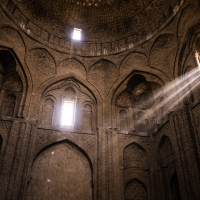Forest Scenes #3 – The Evergreen Boat in a forest lake
Bamboo is a tribe of flowering perennial evergreen plants…
Bamboo is a tribe of flowering perennial evergreen plants in the grass family Poaceae, subfamily Bambusoideae, tribe Bambuseae. Giant bamboos are the largest members of the grass family. In bamboos, the internodal regions of the stem are hollow and the vascular bundles in the cross section are scattered throughout the stem instead of in a cylindrical arrangement. The dicotyledonous woody xylem is also absent. The absence of secondary growth wood causes the stems of monocots, even of palms and large bamboos, to be columnar rather than tapering.
Bamboos are some of the fastest-growing plants in the world, due to a unique rhizome-dependent system. Bamboos are of notable economic and cultural significance in South Asia, Southeast Asia and East Asia, being used for building materials, as a food source, and as a versatile raw product. High-quality bamboo is stronger than steel, a property that has made it a choice in building materials and weaponry.
More than 10 genera are divided into about 1,450 species. Bamboo species are found in diverse climates, from cold mountains to hot tropical regions. They occur across East Asia, from 50°N latitude in Sakhalinthrough to Northern Australia, and west to India and the Himalayas. They also occur in sub-Saharan Africa,and in the Americas from the mid-Atlantic United Statessouth to Argentina and Chile, reaching their southernmost point at 47°S latitude. Continental Europe is not known to have any native species of bamboo.
Recently, some attempts have been made to grow bamboo on a commercial basis in the Great Lakes region of east-central Africa, especially in Rwanda. Companies in the United States are growing, harvesting and distributing species such as Henon and Moso.
Bamboo grows in two main forms: the woody bamboos (Arundinarieae and Bambuseae) and the understory herbaceous bamboos (Olyreae). Molecular analysis suggests that there are 3–5 major lineages of bamboo. Four major lineages are currently recognized: temperate woody, paleotropical woody, neotropical woody and herbaceous.
Bamboo is one of the fastest-growing plants on Earth, with reported growth rates of 250 cm (98 in) in 24 hours.However, the growth rate is dependent on local soil and climatic conditions, as well as species, and a more typical growth rate for many commonly cultivated bamboos in temperate climates is in the range of 3–10 centimetres (1.2–3.9 in) per day during the growing period. Primarily growing in regions of warmer climates during the late Cretaceous period, vast fields existed in what is now Asia. Some of the largest timber bamboo can grow over 30 m (98 ft) tall, and be as large as 15–20 cm (5.9–7.9 in) in diameter. However, the size range for mature bamboo is species dependent, with the smallest bamboos reaching only several inches high at maturity. A typical height range that would cover many of the common bamboos grown in the United States is 4.6–12 metres (15–39 ft), depending on species. Anji County of China, known as the “Town Of Bamboo”, provides the optimal climate and soil conditions to grow, harvest, and process some of the most valued bamboo poles available worldwide.
Bamboo, noble and useful
Bamboo, one of the “Four Gentlemen” (bamboo, orchid, plum blossom and chrysanthemum), plays such an important role in traditional Chinese culture that it is even regarded as a behaviour model of the gentleman. As bamboo has some features such as uprightness, tenacity and hollow heart, people endow bamboo with integrity, elegance and plainness, though it is not physically strong. Ancient Chinese poets wrote countless poems to praise bamboo, but actually they were truly talking about people like bamboo and express their understanding of what a real gentleman should be like. According to laws, an ancient poet, Bai Juyi (772–846), thought that to be a gentleman, a man does not need to be physically strong, but he must be mentally strong, upright, and perseverant. Just as a bamboo is hollow-hearted, he should open his heart to accept anything of benefit and never have arrogance or prejudice. Bamboo is not only a symbol of gentleman, but also an important role in Buddhism. In the first century, Buddhism was introduced into China. As canons of Buddhism do not allow its believers to do anything cruel to animals, flesh and egg were not allowed in the diet. However, people need something nutritious to live; thus, the tender bamboo shoot (sǔn筍 in Chinese) became a good choice. The bamboo shoot is nutritious, and eating it does not violate the canon. With thousands of years’ development, how to eat bamboo shoot has become a part of cuisine system, especially for monks. A Buddhist monk, Zan Ning, wrote a manual of the bamboo shoot called “Sǔn Pǔ筍譜”. He offered descriptions and recipes for many kinds of bamboo shoots.Bamboo shoot has always been a traditional dish on the Chinese dinner table, especially in southern China. In ancient times, as long as people had money to buy a big house with yard, they would always plant bamboos in their garden. Bamboo is a necessary element of Chinese culture, or even in the whole Asian civilization. People plant bamboos, eat bamboo shoots, paint bamboos, write poems for bamboos, and speak highly of gentlemen who are like bamboos. Bamboo is not only a plant, but also a part of people’s lives.
Source: Wikipedia



Bellissima!
Luca